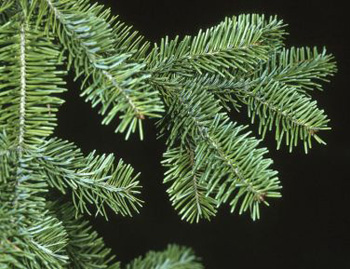Contents:
Common Names | Parts Usually Used | Plant(s) & Culture | Where Found | Medicinal Properties
Legends, Myths and Stories | Uses | Formulas or Dosages | Warning | Bibliography
Scientific Names

- Terebinthine canadensis L.
- Abies balsamea L.
- Coniferae
- Pine family
Common Names
- Canada balsam
- Christmas tree
Parts Usually Used
Leaves, bark and twigs, resin
Back to Top
Description of Plant(s) and Culture

Balsam fir is an evergreen of the pine family, a spire-shaped tree that grows to 60 feet in height. The flattish needles are up to
Another variety: the Native Americans used a balsam fir (Abies lasiocarpa), Shoshone name “Wungobe,” they made a tea from the needles and resinous blisters. They also called this variety Sweet Pine. They mixed grease with the resin to make fragrant hair-oil.
There are 9 species of firs in the United States of the genus Abies.
Back to Top
Where Found
Found in moist woods. From Canada south through New England and along the mountains to West Virginia and Virginia; west through Ohio to northeastern Iowa and Michigan. Found in mountainous regions of Europe, Asia, and the Himalayas.
Back to Top
Medicinal Properties
Antiseptic, diuretic, analgesic, expectorant, stimulant
Back to Top
Legends, Myths and Stories
Balsam fir is collected by cutting the bark blisters or pockets in the wood, around July and August. Turpentine and resin are products of the balsam fir.
The oleoresin is pale yellow to greenish yellow, transparent and pleasantly scented.
The oleoresin is primarily used commercially as a sealing agent for mounting microscope slides.
Back to Top
Uses
Used as a cream or ointment for piles and root-canal sealers.
Native Americans applied the resin externally to treat burns, sores, bruises, sore muscles, and wounds. The leaf tea used for colds, cough, and asthma. Helps rheumatism, inflammation of the bladder, sciatica, neuralgia, epilepsy, erysipelas, erythema, colic, swollen inguinal glands, jaundice, iritis, dropsy, lumbago, worms, typhoid fever, bronchitis.
Back to Top
Formulas or Dosages
Balsam fir,
Bark and twigs: standard tea
Back to Top
Warning
Resin may cause dermititis in some people.
Back to Top
Bibliography
![]() American Folk Medicine
American Folk Medicine, by Clarence Meyer, Meyerbooks, publisher, PO Box 427, Glenwood, Illinois 60425, 1973
![]() Eastern/Central Medicinal Plants
Eastern/Central Medicinal Plants, by Steven Foster and James A. Duke., Houghton Mifflin Company, 215 Park Avenue South, New York, NY 10000
![]() The Herb Book
The Herb Book, by John Lust, Bantam Books, 666 Fifth Avenue, New York, NY. copyright 1974.
 How Indians Use Wild Plants for Food, Medicine & Crafts
How Indians Use Wild Plants for Food, Medicine & Crafts, by Frances Densmore, Dover Publications, Inc., 180 Varick Street, New York, NY 10014, first printed by the United States Government Printing Office, Washington, in 1928, this Dover edition 1974
![]() Indian Herbalogy of North America
Indian Herbalogy of North America, by Alma R. Hutchens, Shambala Publications, Inc., Horticultural Hall, 300 Massachusetts Avenue, Boston, Massachusetts 02115, 1973
![]() Indian Uses of Native Plants
Indian Uses of Native Plants, by Edith Van Allen Murphey, Meyerbooks, publisher, PO Box 427, Glenwood, Illinois 60425, copyright 1958, print 1990
![]() Webster’s New World Dictionary
Webster’s New World Dictionary, Third College Edition, Victoria Neufeldt, Editor in Chief, New World Dictionaries: A Division of Simon & Schuster, Inc., 15 Columbus Circle, New York, NY 10023
